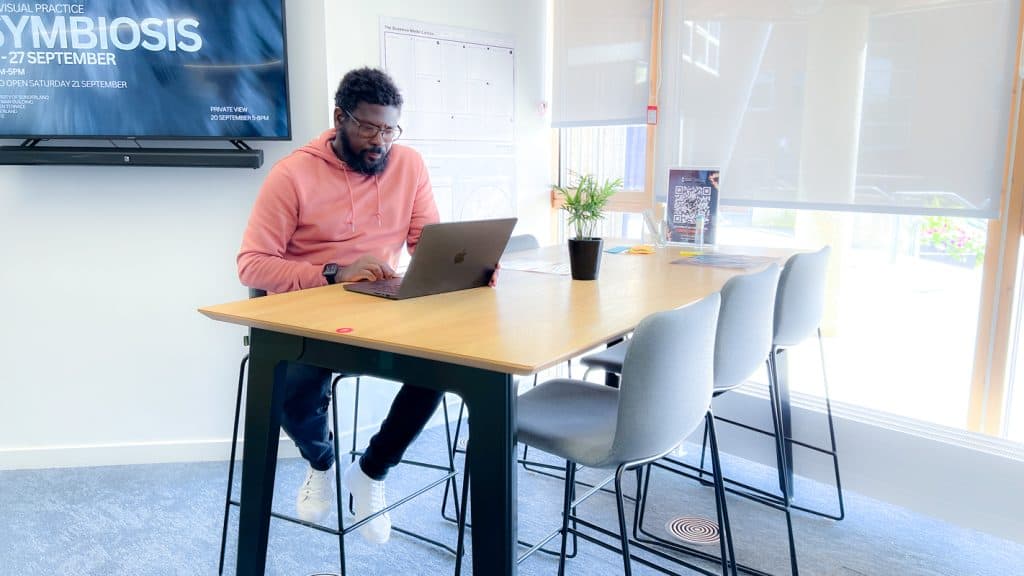
In today’s rapidly changing and competitive market, the ability to increase sales hinges on a crucial yet often underestimated factor: understanding and addressing users need for the success of any digital product. Usability research plays a pivotal role in uncovering these needs and can significantly enhance user satisfaction, boosting sales. This article delves into how usability research helps unlock the potential of your product by improving its design and functionality, and ultimately, its market performance.
Let’s start by knowing what usability research really means.
Usability research is the systematic study of how users interact with a product or system to ensure it meets their needs and expectations. It encompasses a range of methods and techniques to gather insights into user behavior, preferences, and pain points. The primary goal of usability research is to make products more intuitive, efficient, enjoyable to use, and create delightful experiences.
Usability research can involve various methods such as usability testing, user interviews, surveys, and analytics. By understanding how users navigate your product, what challenges they face, and what they appreciate, you can make informed decisions to enhance the user experience.
The connection between usability research and increased sales is both direct and profound. A product that is easy to use and aligns with user needs will naturally attract and retain more customers. Here’s how usability research drives sales growth:
Improves Customer Satisfaction: When users interact with a product that is intuitive and effective, their overall satisfaction increases significantly. This heightened satisfaction often leads to positive reviews, fostering a favorable reputation for the product. Satisfied users are also more likely to make repeat purchases, as their positive experience builds trust and loyalty towards the brand. Such loyalty not only contributes to a stable customer base but also plays a vital role in driving sales. Therefore, improving customer satisfaction through effective usability directly impacts a company’s sales performance and market presence.
Reduces Abandonment Rates: Products with poor usability can frustrate users, leading to increased abandonment rates. Usability research is crucial for identifying these friction points within a product. By understanding where users struggle or encounter obstacles, developers can address and eliminate these issues. This process helps in smoothing out the user experience, thereby reducing the likelihood of users abandoning the product midway through their interaction. Consequently, improving usability helps enhance the completion rates of desired actions, such as transactions or form submissions, which in turn supports better overall engagement and retention.
Enhances Product Appeal: A product that incorporates insights from usability research is often designed with features and functionalities that resonate well with its users. This alignment with user preferences makes the product more appealing and competitive in the market. When users find a product that meets their needs seamlessly, it stands out among alternatives, leading to increased attractiveness and desirability. By understanding and integrating what users truly want, companies can develop products that not only satisfy but also delight their target audience, making their offerings more compelling.
Boosts Conversion Rates: Optimizing the user journey through usability insights is key to improving conversion rates. By streamlining processes, reducing unnecessary steps, and eliminating potential obstacles, the overall ease of use is enhanced. This makes it simpler for users to achieve their goals, whether that’s completing a purchase, signing up for a service, or any other desired action. As a result, users are more likely to follow through with their interactions, leading to higher conversion rates. Effective usability research ensures that the product’s design facilitates user actions smoothly, which ultimately boosts the success of business objectives.
Gain a Competitive Edge: In today’s crowded marketplace, a user-centric approach can set you apart from the competition. User research helps you understand your target audience better than your competitors, enabling you to create a product that truly resonates with their needs. Imagine your competitor has a generic, one-size-fits-all approach, while your user research has revealed specific needs of a niche market. This allows you to tailor your product for maximum impact and win over a loyal customer base.
A UX consultant is your partner in crime when it comes to user research. They bring a wealth of experience and expertise to the table, helping you:
Develop a User Research Strategy: Not all user research is created equal. A UX consultant will help you define your research goals, choose the right methods, and develop a plan to gather the most valuable insights.
Conduct User Research: From crafting effective interview questions to analyzing complex data sets, UX consultants have the skills and tools to conduct user research efficiently and effectively.
Analyze and Interpret Results: Turning raw data into actionable insights is key. UX consultants will help you analyze your research findings and translate them into actionable steps for improving your UX.
Communicate Findings to Stakeholders: Getting everyone on board with your UX strategy is crucial. UX consultants can effectively communicate research results to stakeholders, ensuring buy-in for necessary changes.
Investing in user research is an investment in your product’s future. Consider these statistics:
Companies that prioritize user experience see a return on investment (ROI) of 9,900%.
Every $1 invested in UX design returns an average of $100.
These numbers speak for themselves. User research isn’t just a feel-good practice; it’s a strategic decision that can significantly boost your bottom line.
Usability research involves a variety of techniques, each providing unique insights into user behavior and preferences. Here are some of the most effective methods:
Usability testing involves observing users as they interact with a product to identify usability issues and gather feedback. This can be done in a lab setting or remotely. Key benefits include:
Direct Feedback: Users provide immediate reactions and insights into their experience, highlighting areas for improvement.
Identifies Pain Points: Observing users in real-time reveals obstacles and frustrations that may not be apparent through other methods.
Conducting interviews with users allows for a deep dive into their thoughts, preferences, and challenges. This qualitative method provides rich, detailed insights that are invaluable for understanding the user perspective.
Gathers Detailed Insights: Interviews can uncover motivations, attitudes, and unmet needs that drive user behavior.
Explores Context: Conversations can explore the context in which users operate, providing a broader understanding of their interactions with the product.
Surveys are useful for collecting quantitative data from a larger audience. They can validate findings from other methods and provide a broader perspective on user preferences and satisfaction.
Reaches a Wide Audience: Surveys can gather data from many users, providing statistically significant insights.
Measures Satisfaction: They are effective in measuring user satisfaction and identifying areas for improvement.
Analyzing user data from product analytics tools can reveal patterns and trends in user behavior. This quantitative approach complements qualitative methods and provides a comprehensive view of user interactions.
Tracks User Behavior: Analytics can track how users navigate the product, where they drop off, and what features they engage with the most.
Identifies Trends: By analyzing usage patterns, you can identify trends and make data-driven decisions to improve the product.
Incorporating usability research into your product development process ensures that the product evolves in alignment with user needs. Here’s how to effectively implement usability research:
1. Define Objectives
Clearly define what you want to achieve with your usability research. Are you looking to improve a specific feature, increase user engagement, or reduce abandonment rates? Having clear objectives will guide your research efforts and ensure you gather relevant insights.
2. Choose the Right Methods
Select the usability research methods that best suit your objectives and the nature of your product. Combining multiple methods often provides a more comprehensive understanding of user needs and behaviors.
3. Involve Stakeholders
Engage stakeholders from different departments, including design, development, and marketing. Their input and buy-in are essential for implementing changes based on usability research findings.
4. Conduct the Research
Execute the chosen usability research methods, ensuring you collect enough data to draw meaningful conclusions. Be prepared to iterate and refine your approach based on preliminary findings.
5. Analyse and Act on Findings
Analyse the data collected to identify key insights and actionable recommendations. Prioritize changes based on their potential impact on user experience and business goals.
6. Iterate and Test
Usability research is an ongoing process. Continuously test and refine your product based on user feedback and evolving needs. Regular usability testing helps keep the product aligned with user expectations and market demands.
Investing in usability research offers significant returns on investment by enhancing the user experience and driving sales. One of the foremost benefits is the reduction of development costs. By identifying and addressing usability issues early in the development process, companies can avoid costly changes later. This proactive approach also minimizes the risk of launching a product that doesn’t meet user needs, thereby saving time and resources.
Usability research also plays a crucial role in enhancing a brand’s reputation. Products known for their ease of use and intuitive design foster positive user experiences, which can enhance brand loyalty and attract more users. Satisfied customers are more likely to share their positive experiences through word-of-mouth, leading to increased market share and a stronger brand presence.
Another significant advantage of usability research is its impact on customer retention. When a product consistently meets or exceeds user expectations, it reduces churn rates and increases customer lifetime value. Satisfied users are more likely to continue using the product and to recommend it to others, creating a cycle of retention and referral that strengthens the customer base.
Moreover, usability research drives innovation by providing insights into user needs and behaviors. Understanding what users want and how they interact with a product can inspire the development of new features and functionalities. This process helps differentiate the product from competitors by addressing unmet needs and offering unique solutions.
Ultimately, usability research boosts sales and revenue. A product that aligns well with user needs and is easy to use tends to achieve higher adoption rates and generates more repeat purchases. By optimizing the user experience, usability research directly contributes to these positive outcomes, making it an essential component of successful product development and marketing strategies.
Usability research is a powerful tool for unlocking the potential of your product and driving sales growth. By understanding and addressing user needs, you can create a product that not only meets but exceeds user expectations. Implementing a robust usability research strategy ensures that your product remains competitive, user-friendly, and aligned with market demands.
Investing in usability research is not just about making a product easier to use; it’s about creating a product that users love and want to engage with. As the digital landscape continues to evolve, prioritizing usability research will be key to staying ahead of the competition and achieving long-term success.
By embracing the principles of usability research, you can uncover user needs, enhance the user experience, and ultimately, increase sales. So, start integrating usability research into your development process today and unlock the full potential of your product.





1 comment